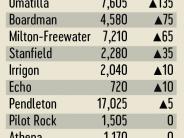Hermiston Population Grows by 360 With Housing to Match
HERMISTON, Oregon — Hermiston’s population grew by an estimated 360 residents between July 2019 and July 2020 according to preliminary estimates from Portland State University’s Population Research Center released this month. The Hermiston Building Department also reported issuing permits for 83 new homes in the city in 2020 through the end of October.
To encourage housing development, the City of Hermiston and Umatilla County committed in 2018 to spend up to $4.5 million on water system expansion projects in Hermiston’s northeast residential growth area, which were completed in late 2019. That effort was in response to statewide research and local developer focus groups that indicated the top barriers to new housing were the availability and price of land served by necessary utilities. The investments by the City and County aimed to bring utilities to serve several hundred acres of newly developable land, and to allow developers to leverage that additional land supply to bargain lower prices for similar land elsewhere in Hermiston and the west end of Umatilla County.
“Hermiston, Umatilla, and Stanfield can really all be thought of as neighborhoods in a larger west-end real estate market,” said Mark Morgan, Hermiston Assistant City Manager. “Our hope with these targeted public investments was certainly to drive housing in northeast Hermiston, but also to allow private developers to negotiate better prices for land region-wide. I believe that is the single best way local government can help add housing supply while holding down housing costs.”
Beginning in early 2018, City staff began actively working with regional developers to take advantage of the pending utility system upgrades. Many of those conversations resulted in the current and planned housing construction now taking place in Hermiston.
“We have two active housing developments under construction in the actual impact area of the utility improvements, but a lot of the impact of leveraging the investment has come in investments and planning elsewhere in Hermiston by keeping developers interested in Hermiston as a whole,” Morgan said. “This effort helped keep the interest of two separate developers who, between them, have broken ground on developments elsewhere in the city which are approved for nearly 250 single family homes, and another 100 single family home development to break ground in the next couple of years.”
Those nearly 350 housing units to come online over the next several years are part of a broader pool of planned housing. Having multiple developers at work has set Hermiston up to capitalize when major changes occur which are well outside of any local control, such as historically low interest rates or material costs.
In response to the COVID-19 pandemic, policy changes from the Federal Reserve have resulted in historically low interest rates. Lower interest rates decrease the cost of borrowing money for things like a mortgage on a home, and therefore can allow borrowers to afford more expensive homes. Meanwhile, U.S. tariffs on imported Canadian lumber in 2019 substantially increased the price of one of the single largest input costs in new homes, and that price constraint was then exacerbated by the interest-rate-fueled housing boom and demand for lumber in 2020. All of these macro-economic forces impacting the local housing market can make it difficult to gauge the effectiveness of local efforts to increase supply and hold down prices.
“I know that it’s a tough pill to swallow, from a housing-affordability standpoint, when we see median home sale prices continue to rise nearly 7% this year in Hermiston,” Morgan said. “However, I believe that if we hadn’t done the expansive work in 2017 through 2019 to actively build a deeper bench of housing developments just waiting for the right conditions to pull the trigger, then we would have lost out on much of this interest-rate driven building-boom, which would have constrained supply further, driven sale prices even higher, and reduced housing affordability.”
Another factor helping to prop up and drive new home construction in the greater Hermiston area is the region’s relative economic stability amid the COVID-19 induced recession. The immediate Hermiston area is included in economic statistics for Umatilla County as a whole, but also shares broadly in many of the economic indicators from Morrow County. Prior to the COVID-19 pandemic, Umatilla and Morrow Counties saw average wages rise by 4% and 5% respectively in 2019, according to data released by the Oregon Employment Department in September 2020. The Hermiston region fared relatively well through the COVID-19 induced recession of Spring 2020 as well, especially due to diversification and food production.
While Umatilla County’s unemployment rate spiked to 13.9% in April 2020, Morrow County’s unemployment rate maxed out at 8%. This likely highlights the underlying difference in economic conditions between the west end of Umatilla County, which is heavily reliant on agricultural production and processing, and the east end, where the largest employer in Umatilla County, the Confederated Tribes of the Umatilla Indian Reservation, temporarily shuttered its largest employment operation in Wildhorse Resort and Casino in response to the pandemic.
Both Umatilla and Morrow counties experienced startlingly fast employment recovery relative to the rest of the state and nation. Umatilla County’s unemployment rate had fallen to just 6.2% by September, while Morrow County’s had fallen to 5.3%. For historical context, Umatilla County’s jobless rate exceeded 6.2% in June 2009 as a result of the global financial crisis, and that rate did not get back down to 6.2% until August 2015.
“Prior to 2020, the main concern that we heard from our business community was access to a large enough workforce to meet their needs, and available housing was viewed as one of barriers to that need,” Morgan said. “I think the rapid and robust return of employment to our region from the sharpest economic decline on record tells me that supporting new housing development across western Umatilla County will continue to be a major need in 2021 and beyond.”


